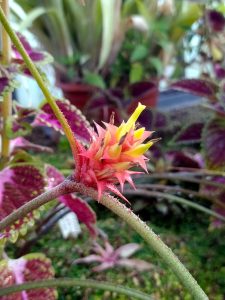Growing Acanthostachys strobilacea from seed

Basic plant info
Acanthostachys strobilacea is a tropical plant from the bromeliads family that natively grows in south America. In nature it grows as an epiphyte like other bromeliads. It has a drooping look which makes it suitable for hanging baskets or positions on the shelves. It needs quite a lot of light and tolerates drought. The best option to kill it is by overwatering. Especially during the winter when it grows much slower. Its colorful inflorescent resemble tiny pineapple.
Collecting seeds
When the flower is pollinated (it can be self pollinated), small fruits start to develop. As the inflorescent loses vivid color and turns dark brown, fruits are most likely ripe and seeds fully developed. At the beginning, they contain a lot of moisture and can eventually dry out. The fruit contains sticky substance and the seeds tend to stick to your fingers when you squeeze them out of the fruit. You can easily wash them, or use water to dilute the gluey substance when collecting the seeds. The seeds and the fruits have a really pleasant fragrance, I’m not sure about the flavor though. I’m not keen on experimenting with possibly poisonous fruit. 🙂
Sowing the seeds
Like most of the tropical and subtropical plants, you should sow the seeds as soon as you collect them. They don’t need dormancy of any kind and lose viability quickly. I started germinating the seeds immediately. The seeds sprouted in only one week with extremely high germination rate. Acanthostachys strobilacea needs very porous and easily draining substrate, just as any other Bromeliaceae epiphytes. To make the appropriate substrate, I mixed peat, substantial amount of perlite and a bit of compost, compacted the mix lightly and placed the seeds on top. I covered the seeds with a millimeter of silica sand to keep the seeds evenly moist. I misted the surface daily just to make sure the top layer didn’t dry out.
Seedlings
It only took a week for the seeds to start germinating. The seeds are decent sized, so they should start growing vigorously from the start. Since the germination rate was high, they were starting off already a bit congested. When the seedlings get large enough to be picked up using your fingers, at 3 or 4 leaf stage, it’s easy to separate them and plant them individually into easy draining substrate. Since bromeliads are susceptible to root rot if water doesn’t drain well enough, they should be planted into smaller sized pots first and gradually up-potted. Terra-cotta pots are much safer option than plastic containers.
